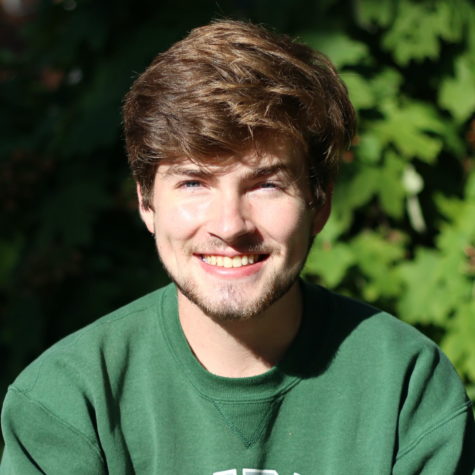A look into CWRU’s coronavirus decision-making
Back-to-school leader Peter Poulos on the university’s perspective and priorities
September 11, 2020
Peter Poulos, J.D., keeps a low profile among Case Western Reserve University students; in fact, most have never heard of him. However, as the university’s general counsel, chief risk management officer and deputy secretary of the corporation, Poulos manages considerable responsibilities. Actions directed by him—especially during the coronavirus pandemic, as he became the university’s return-to-campus leader—significantly impact the student experience at CWRU.
Poulos is no newcomer to CWRU; he has been part of the community for over three decades.
Prior to his professional career, Poulos was a student at CWRU’s School of Law, where he graduated summa cum laude. Furthermore, his family has a rich history with CWRU. Two of his sisters and one of his cousins attended some combination of undergraduate and graduate schooling at CWRU.
Poulos began doing legal work for the university in 1992 as a partner in the law firm Taft, Stettinius & Hollister, which handled CWRU’s legal necessities. Starting in 2007, Poulos joined the Office of General Counsel as part of a larger shift to move legal work in-house.
“[Working for CWRU] was a dream job when I graduated law school,” said Poulos. “[It was] a little bit unusual for a dream job to be to work for a university.”
Poulos’ deep-seated appreciation for the CWRU community is what propels this unusual dream of his.
Poulos explained: “To me, this is home. In fact, I just love the community, being here. So it just kind of defines me both in my personal and legal life.”
Since the coronavirus began, Poulos has played an even more active role in directing wide-ranging university actions.
CWRU has an emergency plan for times like these, which nests decision-making among two groups: One, led by Barbara Snyder, CWRU’s outgoing president, is focused on developing policy and includes senior advisers, representatives from University Health and Counseling Services and emergency management experts. The other, according to Poulos, who leads that group, is called “operations.” It “takes what’s been decided and makes sure it’s implemented correctly.”
Poulos’ operations group is much larger than the policy group. Composed of approximately 30 individuals, operations group members come from a variety of different university departments, including University Health, Human Resources, the Division of Student Affairs and the Office of the Provost, as a sampling. Input from deans, faculty and students were considered by both the policy and the operations groups. All told, over 100 people have been involved in operational planning over the last six months.
“The operations group really just helped coordinate all of the different moving parts that were needed to make sure that whatever plans and policies we were implementing in dealing with the pandemic were done in a coordinated fashion,” said Poulos.
Poulos further emphasizes that teamwork was essential and that everyone stepped up.
At the beginning of the coronavirus pandemic, both the policy and the operations groups were meeting almost daily, according to Poulos, who credits Snyder’s leadership with getting everyone through this intense time.
“The leadership demonstrated by Barbara Snyder. Just so inspiring,” said Poulos. “Every day, she was here from the beginning through the end. During the times when there was the stay at home order that impacted the rest of Ohio, she was here, making sure that people recognized what we were trying to do.”
Poulos further explained: “[Snyder] cared not only about the big strategic things, but I can tell you she cares about individual students, faculty and staff—about how they are being impacted.”
This care for individuals was an important part of Poulos’ decision-making as well.
“I think of risk in terms of our students and faculties,” said Poulos. “The foremost thing of risk is all of our planning has to make safety the first priority.”
Safety, according to Poulos, includes a variety of different metrics. Along with the obvious concerns being about the virus, Poulos also recognizes the mental toll it has taken on students. In fact, he’s seen it firsthand in his own college-aged children.
“When thinking about risk and safety, in the end, I think of it as the welfare of our entire campus community,” Poulos said. This campus community includes both students that were able to return and students who weren’t, as well as faculty, staff and others involved with the university.
Requiring some students to remain home was not Poulos’ ideal scenario. Unfortunately, the spike in the rate of infection at the end of the summer necessitated these drastic measures.
“[It was] a really hard call that the president made. [It] was her decision after getting feedback from all of these different members of both the policy and operational groups … they were [in] agreement that [we] needed to essentially ramp down the number of students to benefit the entire campus community,” Poulos said. “So while I wish it could have been different, it was the right decision to make.”
Even after that big decision was made, the operations group’s job did not end; in fact, Poulos and other group-members continue to proactively evaluate the coronavirus situation.
“All those 100 to 200 people that helped to plan for six months? Well now they’re still going forward—but just in a different way,” Poulos said. “They’re now looking at our plans and saying, ‘Are they working? Do we need to readjust? Are there any gaps we didn’t realize?’”
“I wish that we had this magic button that we could push,” said Poulos, “But we’re going to keep working as hard as possible to try to give our students the best experience we can give in the environment we’re in.”


